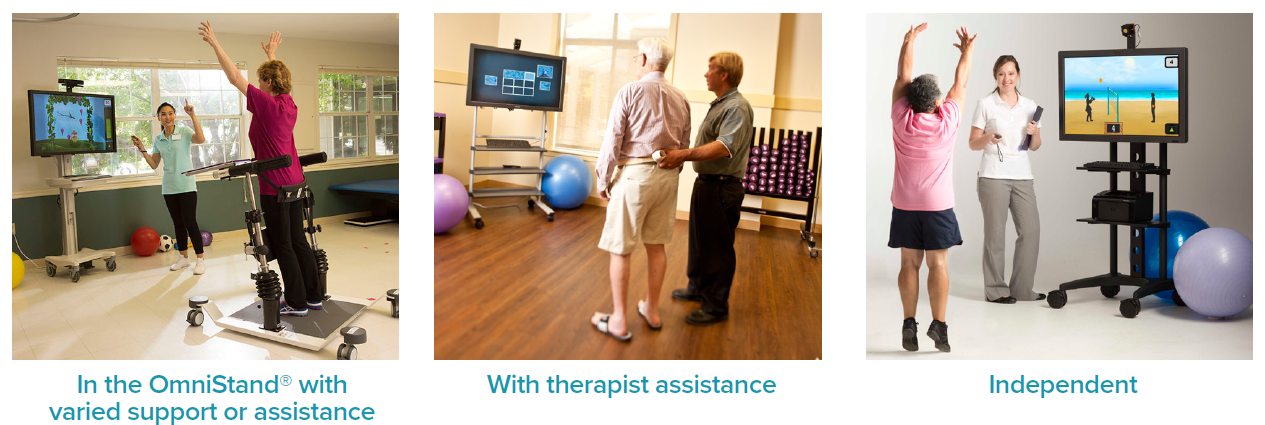Over the past several years, the body of evidence on the effectiveness of virtual reality (VR) in rehabilitation has significantly expanded. VR has been studied for a variety of diagnoses including stroke, Parkinson’s disease, multiple sclerosis, dementia, burns, pain, and total knee arthroplasty. VR helps enhance patient involvement and motivation while increasing the repetitions and duration of exercise. Benefits addressing ADL performance, balance, gait, pain, and cognition have been reported.
- Long-term improvements in cognitive and psychological outcomes were achieved with computerized or virtual reality cognitive training for individuals with mild cognitive impairment (MCI) or dementia. (Coyle, et al., 2015)
- VR/gaming-based upper extremity rehabilitation post-stroke appears to be more effective than conventional methods. (Karmians, et al., 2019)
- VR has the potential to improve balance and gait in patients with neurologic conditions and brings additional benefits when combined with conventional rehabilitation. (Porras, et al., 2018)
- VR used in rehabilitation for patients with Parkinson’s disease improves a number of outcomes and may be considered for routine use in rehabilitation. (Triegaardt, et al., 2019)
- There is a strong level of evidence for the use of VR as an effective treatment in reducing acute pain. Promising results have also been achieved for chronic pain, but further research is needed for long-term chronic pain reduction. (Mallari, et al., 2019)
The use of virtual reality in therapy seems like playing games to the patient and that is what makes it fun, but in order to be an effective treatment the patient’s impairments and function need to be the focus of the exercise/activity chosen. VR in rehabilitation is a form of dual-task training (DT), working on one activity while simultaneously working on additional tasks (cognitive or motor) and should be progressed according to the patient’s functional and mobility level.
OmniVR® Virtual Rehabilitation System can be used as an integral part of an evidence-based outcome-focused clinical program that is individually designed and progressed based on patient ability.

The question should no longer be if virtual reality should be part of an individual’s rehabilitation, but instead how to individualize and progress the therapeutic exercise and activities performed with this technology to best reach the patient’s optimal functional outcomes. To quote David Putrino, a prominent VR researcher at the School of Medicine at Mount Sinai, “VR is ready for primetime”.
References:
Coyle, H., Traynor, V., Solowij, N. (2015). Computerized and Virtual Reality Cognitive Training for Individuals at High Risk of Cognitive Decline: Systematic Review of the Literature. American Journal of Geriatric
Psychiatry, 23(4), 335-359. doi: 10.1016/j.jagp.2014.04.009
Karamians, R., Proffitt, R., Kline, D., Gauthier, L.V. (2019, Dec 7). Effectiveness of Virtual Reality – And Gaming-Based Interventions for Upper Extremity Rehabilitation Post-Stroke: A Meta-Analysis. Archives of
Physical Medicine and Rehabilitation, (Epub ahead of print), DOI:10.1016/j.apmr.2019.10.195
Mallari, B., Spaeth, E. K., Goh, H., Boyd, B. S. (2019). Virtual reality as an analgesic for acute and chronic pain in adults: A systematic review and meta-analysis. Journal of Pain Research, 12, 2053-2085.
doi: 10.2147/JPR.S200498
Porras, D. C., Siemonsma, P., Inzelberg, R., Zeilig, G., Plotnik, M. (2019). Advantages of Virtual Reality in the Rehabilitation of Balance and Gait: Systematic Review. Neurology, 90(22), 1017-1025. doi: 10.1212
WNL.0000000000005603
Putrino, D. (2019, November). Rehabilitation for a New Generation: Technology, Innovation and the 21st Century. Lecture presented at ACRM Annual Conference, Chicago, IL.
Triegaardt, J., Han, T. S., Sada, C., Sharma, S., Sharma, P. (2019). The Role of Virtual Reality on Outcomes in Rehabilitation of Parkinson’s Disease: Meta-Analysis and Systematic Review in 1031 Participants.
Neurological Sciences, (Epub ahead of print). doi: 10.10007/s10072-019-04144-3
